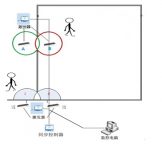
Dual-frequency RFID personnel indoor positioning management plan
[ad_1]
1. Project background
GPS positioning has been widely used in outdoor personnel positioning, but for indoor personnel positioning, because GPS signals cannot cover, it cannotObtaining the specific location information of the personnel indoors brings inconvenience to the location management of the personnel. Apply 433MHz+125KHz dual-frequency RFID technology,Accurately locate the indoor location of personnel, which will effectively improve production and office efficiency and personnel management.
2. Program features and advantages
1. 433MHz RFID has the characteristics of strong diffraction, strong penetration and long transmission distance, and is suitable for various indoor environments.
2. The card reading distance is far, no need to swipe the card close, and it will automatically recognize the long distance.
3. Convenient to carry. Due to the powerful diffraction performance of 433MHz, the electronic tag can be placed in a carry-on bag or can be hung on the chest in the form of a badge. It is easy to carry.
4. Due to the strong diffraction performance of 433MHz, it solves the problem of low recognition rate caused by human body occlusion in other RFID technologies, and overcomes the false alarms and false alarms of other RFID technologies.
5. Precise control and reliable identification. The boundary of the excitation zone is clear. The boundary error is about 0.3 meters. The signal excitation distance between the exciter and the electronic tag is within 5 meters, which overcomes other RFID technologies that are greatly affected by the climate, electromagnetic environment, and building environment. And caused the recognition rate problem.
6. The electronic tag is usually in the standby state and emits signals only when it enters the excitation zone. It has the characteristics of ultra-low power consumption, no radiation damage, and safe and reliable use.
7. Ultra-low power consumption, long service life of the electronic tag (under normal circumstances, the battery life of the tag exceeds 5 years).
8. Allow personnel to enter and exit quickly in parallel state (maximum parallel capacity is 100 people).
9. It can be installed in the ground or on the ceiling without affecting the appearance of the door, and it has more advantages in the management of the entry and exit of the ultra-wide door.
Three, the main function
1) Personnel management:
Personnel information and electronic label numbers correspond one-to-one, and the information is stored in the system, providing a convenient and quick management and maintenance interface.
2) Real-time positioning:
Real-time display of personnel location information, and maintain personnel location information records for viewing.
3) Map display:
Display the layout of different regions in the form of a map, display the current personnel location information, and query statistical information.
4) Historical track:
The historical track can be inquired according to the personnel or the electronic tag number.
5) Press key to alarm:
When a person presses the button of the electronic tag, the system sends out an alarm and prompts the identity information and location information of the alarm person.
6) Alarm in restricted area:
Different areas can be divided, and the restricted area alarm conditions can be set in the area, and the alarm will be automatically alarmed when a person enters the restricted area.
7) Low battery alarm:
When the electronic tag battery voltage is low, the background automatically prompts all the electronic tag numbers in the low-power state, so that the electronic tags can be replaced in time.
8) Record query, statistics and reports:
It can query historical records and statistical information such as personnel location, alarm conditions, and processing conditions, and has the function of exporting reports.
Four, basic principles
1. Schematic diagram

The system consists of “monitoring computer”, “125KHz exciter”, “synchronization controller”, “125KHz antenna” and “125KHz+433MHz dual frequencyRFID electronic tags (hereinafter referred to as electronic tags)”.
2. Working principle
1) Each person is issued an electronic tag, so that one person has one card.
2) Install an exciter at the entrance and exit of each room, and install an excitation antenna on both sides of the entrance and exit. When the person carrying the electronic tag is in the excitation zone of the 125KHz excitation antenna, the electronic tag is awakened and sends a 433MHz radio frequency signal to the outside.
3) The exciter obtains the electronic tag signal (the signal data includes the electronic tag ID, excitation antenna ID, excitation signal strength, low battery indication, etc.) and transmits the information to the monitoring computer.
4) The monitoring computer analyzes the collected data, and obtains information such as the specific location of the personnel and the alarm.
[ad_2]





